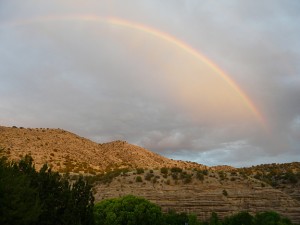It’s the “Waiting for the Rains Time” in the Southwest. After a mostly-dry and colder-than-usual La Niña Winter, and a cool and even drier Spring, the entire Southwest is exceptionally dry, and every living thing — humans, animals, birds, and plants — is waiting. Waiting for the annual North American Monsoon or Southwest Monsoon rains that traditionally begin in New Mexico and Arizona around the last week in June to the first two weeks of July.
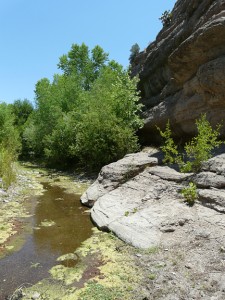
Here at Casitas de Gila Guesthouses and Nature Preserve it is no different, although you wouldn’t know it standing in front of the Casitas and looking at Bear Creek below, where a lush green oasis of cottonwoods, sycamores, willows, oak, ash, alder, and seep willow beckons our guests for a shady respite from the Summer sun. For even in a very dry year, such as this year, Bear Creek maintains a small, yet persistent, flow below the Casitas, a flow that’s a few inches deep and a few feet wide, fed by numerous stream-bed springs scattered along its sinuous course from the Piños Altos Mountains on the horizon to the North and East.
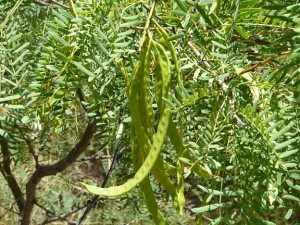
At a distance, except for the tell-tale dry brown grass left over from the heavy rains of last Summer and Fall, the hills and mountains bordering Bear Creek look much as they always do, checkered with numerous dark-green juniper and piñon trees and abundant, bright, yellow-green clumps of Honey Mesquite (Prosopis glandulosa), their abundant golden efflorescent flowerings of last month now replaced by copious quantities of long, slender, immature green bean pods.
Yet upon closer inspection, the signs of the current extended dry are everywhere, and some of the apparent greening and flowering is deceptive. The flowering and fruiting of the Honey Mesquite, for example, cannot be trusted as evidence of recent rainfall as this plant is well adapted to the vagaries of desert precipitation. Mesquite has an extensive shallow root system to capture the briefest shower, plus deeply penetrating roots that tap into residual moisture stored deeper underground from earlier months of abundant precipitation, such as we had during the last half of 2010. A similar deception belies the current profusion of fragrant flowers on the Desert Willow (Chilopsis linearis), now blooming in the dry washes, where its deep roots can almost always find moisture no matter how dry the surface conditions.
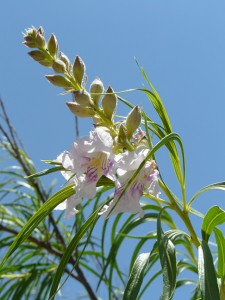
One who is familiar with the life cycle of these high desert plants will quickly notice the absence of certain other things as well, such as how the Scrub Oaks of the upland hills, which, as usual, shed last year’s leaves in late Spring, but have not put out new ones yet – they’re just waiting. Or how many of the plants which are normally flowering at this time of year, such as the Prickly Pear Cactus and the elegant Soaptree Yucca, are conspicuously barren – also waiting. Or that the typical annual flowers of Spring and early Summer, such as Bloodweed, Evening Primrose, Thistle, didn’t germinate at all this year – later maybe, or maybe next year, or even five years from now … most plants of the high desert are very, very patient.
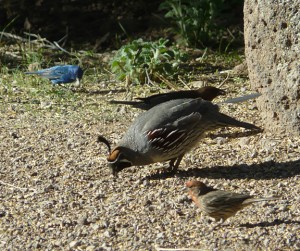
Current bird life and activity, both resident and transient, in the Casitas de Gila Nature Preserve is normal for this time of year, although the variety and numbers seem increased over last year. In part, this is because of the continuing presence of water in Bear Creek, but also due to the availability of several flowering Spring plants along the creek, and the abundant seeds left from last year’s extreme growth and overproduction, resulting from last year’s prodigious Summer rains. Another probable reason is the fact that we have been feeding the birds here, both at the Casitas as well as at our house and office, every day, for the past 13 years! It seems likely that it is probably now well known by our feathered friends that we feed regularly and generously, offering a smorgasbord of cracked corn, wheat, oats, white millet, whole milo, sunflower seeds, thistle seed, suet (three flavors), and hummingbird nectar (several gallons a week during season)! So whether the increased variety and numbers this year are due to the extended dry and the continuing flow of Bear Creek, or the Casita-free-lunch-entitlement-program is very difficult to judge conclusively! We think we may have created a monster. It’s somewhat scary to think of what might happen if we would quit and subject our avian friends to a sign-of-the-times austerity program. An Alfred Hitchcock movie quickly comes to mind …
By now most of the stock tanks and natural springs in the surrounding hills and mountains have dried up, so Bear Creek is the sole source of dependable water for many of the animals in the area. Accordingly, during the past month the numbers and variety of animals visiting Bear Creek have increased dramatically. In this case it has to be the presence of water in Bear Creek, because we have never fed the wild animals (and never will).

Ever since the first two ewes appeared this past May 6, there has been a steady parade of Rocky Mountain Bighorn Sheep visiting the cliffs across from Casitas de Gila, in groups numbering anywhere from 2 to 20 at a time. They stay anywhere from just a night or two to up to a week, enjoying the safety of the cliffs at night, and feeding on the extensive browse available above the cliffs and the fresh green vegetation and water in Bear Creek by day. The groups consist of mostly or entirely ewes with lambs, but occasionally will be accompanied by a young ram or two. Watching this ritualistic procession for the past two months leads one to the hypothesis that in addition to the perks of place mentioned above, a couple other reasons could be in play here. One may be the probable instinctual entrainment of this herd’s geographical range and favorite haunts upon the young lambs, and the other may be that during the early weeks of the life of a newborn lamb the herd is greatly vulnerable to predation, primarily from Cougar and to a lesser extent Coyotes and Wolves, and therefore they have to keep moving. Another possibility might be that the sheep find the guests at Casitas de Gila interesting to observe as well!
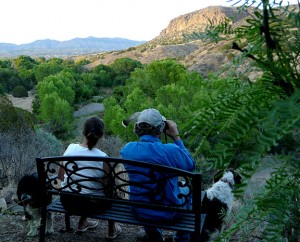
For the past three weeks Becky and I have taken to spending a half an hour or so right at dusk sitting out on benches at the Bear Creek Overlook and in front of the office with our binoculars to observe the activity below along Bear Creek. Scarcely an evening goes by that we aren’t rewarded. We have watched Mule Deer feasting and frolicking, Striped Skunks scratching for insects, Jackrabbits and Cottontails nibbling, Collared Peccary (javelina) foraging, Coyotes hunting, and Bobcats stealthily searching. Also, we have observed stoic Great Blue Herons fishing for minnows, Wild Turkeys strutting, and Black Hawks, Cliff Swallows and Mexican bats soaring. During the day, a walk along the trails winding through the floodplain of Bear Creek can be a veritable paradise for observing various types of animal tracks and scat. If one takes the time, and uses the guidebooks in the Casitas, one will discover the tracks of all of the above, and maybe even the unmistakable print of a small Black Bear, as Bower, Chloe and I discovered last week, and as two of our guests saw twice in the flesh just yesterday.
Like all residents of the American Southwest, here at Casitas de Gila Guesthouses we look forward to the onset of the Southwest Monsoon season (also called North American Monsoon) which begins in late June or early July and ends about the middle of September. Monsoons, in general, result when in Late Spring or Early Summer the interior landmass of a continent heats up faster than that the adjacent ocean. As the hot air over land rises, this causes moisture laden air from the oceans to move landward where it then precipitate as rain. In the Southwest U.S. this pattern begins in the mountainous interior of Mexico where high level moisture is carried in from the Gulf of Mexico by easterly winds aloft. As the season progresses, low level moisture laden air is also drawn in from the Gulf of California. As the forests in the mountains of interior Mexico green up, evaporation and plant transpiration add to the moisture content of the air. Gradually, the monsoonal storm pattern intensifies, and the monsoonal ridge shifts northward into Arizona and New Mexico to produce the much-welcomed rains of Summer.
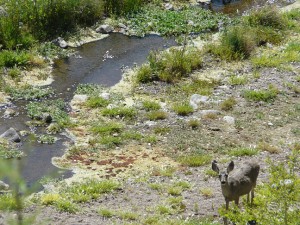
This Southwest Monsoon, or Monsoon Season as it is called locally, is quite different from the South Asian monsoon where the rainy season of the Summer months is one of persistent widespread deluge and extensive flooding, which can result in difficult hardship, but is endured with acceptance as it provides up to 80% of the annual rainfall for the Indian subcontinent. The Southwest Monsoon, while it does provide on the average 50% or more of the annual rainfall in New Mexico and Arizona, is considered more of a summer blessing and anticipated treat by the people who live here. During the Southwest Monsoon season it doesn’t rain constantly for days on end; rather, the rain is much more sporadic, spread out over some eight weeks, and characterized by short, 15-30 minute afternoon thunderstorms. These thunderstorms can be quite intense, and are great fun to watch as they build into towering, colorful thunderheads over the mountains which then slowly advance toward you to drop up to as much as 2 or 3 inches of rain before dissipating once more to sunny, clear blue skies. Almost always these thunderstorms are accompanied by a single, double, or even a triple rainbow, plus a lingering and most refreshing drop in temperature. Runoff from these storms is immediate and can provide quite a spectacle of Nature when observed from in front of the Casita building as the waters surge down Bear Creek 80 feet below. Yet, within a half-hour or so after the sun comes out, the ground and roads are dry again, and except for the odd puddle, evidence of the recent storm is difficult to find.
This year, because we have had very little rain for six months (.04 inches to date here at the Casitas de Gila Nature Preserve since January 1), and because there has been such strange weather globally (a severe winter followed by disastrous fires, floods, tornadoes, etc.), there is great concern, anticipation and speculation in the Southwest regarding this year’s Monsoon Season. Will this year be an exceptionally strong Monsoon or a weak one? If one Googles the topic, one quickly finds that the projections by the various experts are not consistent and the various projections bracket the total range of possibilities. Recently, in response to this important question, the University of Arizona’s Climate Assessment for the Southwest (CLIMAS) Program has started a new publication called the Southwest Monsoon Tracker, which is available online and will be updated each month until September. Likewise, the National Weather Service in Tucson has a similar program called Tracking the Monsoon.
For the past 13 years, Becky and I have personally found this whole Monsoon Season phenomena very fascinating. From my past experience in trying to understand the natural world of any new area, I have learned that when one really wants to understand the truth about a local phenomena of Nature, it is always useful to seek out those respected “old timers” who have lived close to Nature and through the various cyclical climate changes that today’s experts can only research from old data. So it was in this context that a couple of weeks ago I was visiting with such a local man and friend, who was born, raised, and has spent a long lifetime in this area working with Nature on ranches and in the mines. His experience, knowledge, and wisdom concerning the natural world of the local area is held in high esteem by his local peers, and it is always enlightening talking to him. Eventually, our discussion finally came around to this year’s Monsoon Season. When I asked what he thought the Monsoons would be like this year, he replied, with a twinkle in his eye: “Well … just the other day I was talking to an ‘old timer’ I know and asked that same question. And he told me, ‘Well … when you have these here strong winds like we’ve been a havin’ this late in the year, you can bet your boots that it’s goin’ to be one humdinger of a rainy season’.” At this point, the conversation with my friend turned, naturally, to discussing just how unusual these exceptionally strong, late-in-the-year winds that we have been experiencing of late truly are. So for what its worth, according to one local “old timer”, we just might have a humdinger of a rainy season here in Southwest New Mexico this year! But then again, maybe we won’t. And no, in case you were wondering, at the time, I didn’t think it would be appropriate to ask my friend what he thought of that “old timer’s” opinion!
Ah, the mysteries of Nature!
So now we all wait. And hopefully it won’t be a long wait. Why just this morning I looked at the 7-day National Weather Service forecast and lo and behold, for the first time this year, there’s a 10% chance of showers each day and night for an entire week! Could it be that,the Monsoon of 2011 is about to begin?
